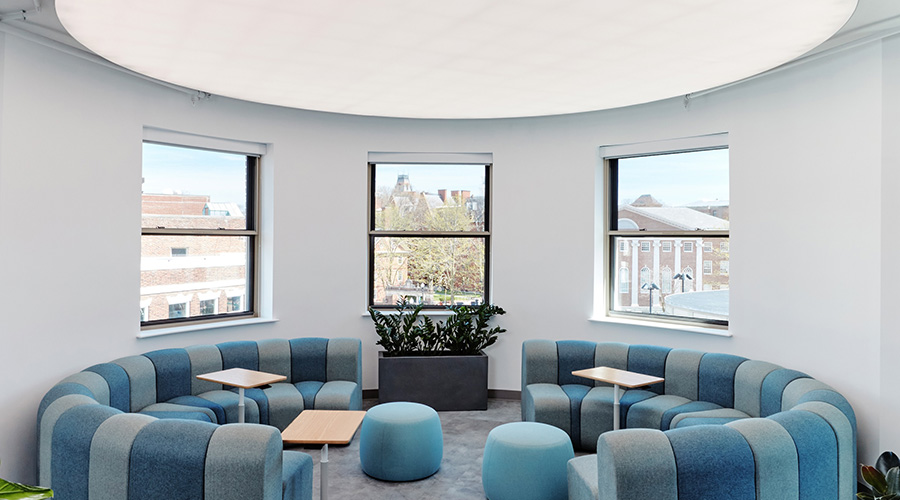What Quiet Offices Sound Like
Advances in technology give facility executives new choices for soundmasking
A big-box retailer closes a store, leaving behind an empty shell that is eventually leased and converted into a busy, noisy call center. The new tenant needs a soundmasking system that allows a large number of people to have conversations without interfering with one another.
The building’s deck, however, is 30 feet above the floor, and the new tenant doesn’t want to use mechanical lifts and other equipment to install a soundmasking system that is incorporated into the ceiling and plenum. The tenant opts to install an access floor, putting a soundmasking system, as well as some other building equipment, below people’s feet.
Soundmasking systems are typically associated with ceilings, but locating them in access floors or in spaces without ceilings is one of several innovations the industry has seen in the past few years. Systems offer more functionality than in the past, provide a range of options for control and deliver better sound.
Producing a sound soft and steady enough that it covers human speech frequencies yet isn’t distracting is a balancing act. A soundmasking system makes it difficult to understand other people’s conversations, yet allows the people involved in a discussion to easily hear each other.
“In an office environment, and particularly in an open-plan environment, we have a few tools to work with and soundmasking is one of them,” says Kring Herbert, a principal with Ostergaard Acoustical Associates. “If you can cleverly elevate the background sound level without annoying people, you’ll have a quieter environment and give people what they need.”
Acoustics: A Growing Concern
Soundmasking has come a long way in the last several decades. In the 1960s and 1970s it was almost an afterthought, a concept that only a few engineers understood, says Jonathan Leonard, vice president of Lencore Acoustics Corp. But in the 1980s, the growth of open plan offices made acoustical privacy a concern. As permanent walls came down and partitions went up, office employees found they couldn’t help overhearing co-workers’ conversations. Those distracting conversations became a leading complaint — and a growing drain on worker productivity.
From an acoustical standpoint, things have only gotten worse since the 1980s. Workstations have shrunk, bringing people even closer to their neighbors’ conversations. System furniture panels are often lower, reducing barriers that can block sound.
Those developments raised interest in soundmasking as a way to restore some of the lost acoustical privacy. At the same time, the Health Insurance Portability and Accountability Act of 1996, known as HIPAA, established federal protections for the privacy of protected health information for individuals. That brought sound and acoustics to the forefront for the medical profession, much as the Financial Modernization Act of 1999 did for the financial services industry.
Even as concerns about acoustical privacy grew, design trends sometimes made it harder to address that issue. Consider the use of open plenums in commercial office space. Whether new or renovated space, these areas typically have little porous material to absorb sound and don’t have the plenum space where speakers are sometimes placed. “The square footage in cubicles has gone down and people feel closed in, and so companies go vertical,” says Kenneth Roy, senior principal research scientist with Armstrong World Industries. “In these situations, you have the same acoustical problems as before but now you don’t have a ceiling.”
Armstrong’s answer to this was to develop speakers that, instead of being hidden in a plenum, look like ceiling tile and radiate sound directly into a space. When used in exposed structures, the speakers can be installed in acoustical clouds that hang, giving a ceiling-type feel. “Our goal is to get good performance in the workspaces,” Roy says. “We’re trying to make sure the customer gets a very good interior environment.”
Location, Location, Location
In some cases, it’s not practical to have a soundmasking system in a ceiling. Dynasound Inc. has installed systems in access floors, and one of its speakers can be used in access floors as shallow as one-and-three-quarter inches. That was the strategy used in the big-box retail location that was turned into a call center. “We put soundmasking underneath the raised access floor,” says Thomas Koenig, president of Dynasound. “It’s a better installation when it comes to uniformity.” There were also savings on installation; for example, mechanical lifts were not required. Koenig sees underfloor soundmasking as an important strategy for the future. “Raised access floors are becoming more popular,” he says.
Some soundmasking systems can be located in spots other than ceilings and access floors. For example, Cambridge Sound Management makes a direct-field sound system with emitters that are typically mounted in ceiling tiles but can also be placed on other surfaces, including furniture, office partitions, beams, metal and wood. The speakers project sound directly into the space, require no tuning and use very little power.
Installation is on a grid pattern based on ceiling height, and the office space can be as small as 50 square feet to more than 1 million square feet. A single zone can be from 50 square feet to 30,000 square feet. Multiple zones can be created. An upcoming release system will make it easier for facility executives to monitor the system: If an unauthorized person makes a change to it, for example, an e-mail is sent to the facility executive.
Companies need to address noise reduction and privacy in an ever-changing environment, says Cambridge Sound Management President Jack Heine. “Furniture trends are changing, cubicles are smaller. Distractions are way up and privacy is way down.”
Systems Offer More Functions
Today’s soundmasking systems, which can cost from $1 per square foot to $5 per square foot, according to Herbert, have an array of functions that make it easier for users to get the masking they need precisely where and when it’s needed. For example, some systems can be divided into zones, allowing one area to have different masking characteristics than that of an adjacent zone. Some systems also have timer functions, allowing masking to occur during certain days and hours of a month.
Those changes aren’t just occurring in offices, where soundmasking systems are common. The health care industry also employs soundmasking, using the systems in doctor’s offices, exam rooms, pharmacy consultation areas and more, particularly following the passage of HIPAA. The financial services industry and the military also employ soundmasking systems.
Perhaps it’s not surprising that another recent innovation in soundmasking is the ability to have a system integrated into so-called smart buildings. For example, Lencore Acoustics has soundmasking products that are controlled from a central volume control. On one product, those adjustments can be made for up to 50 main units and covering up to 33,000 square feet systemwide. Another product has global volume adjustments that can be made remotely for up to 150 masking units covering the same amount of square feet.
Today, smart building integration makes it possible to use the Internet to control a soundmasking system hundreds or thousands of miles away. One of Lencore’s soundmasking systems in a building in Singapore, for example, is able to be “viewed” by a staff in Philadelphia using a virtual private network. “That gives us the ability to be called from literally anywhere and change something,” Leonard says. “You can do it, literally, on a moment’s notice.”
System Evolution
When K.R. Moeller Associates launched the LogiSon Acoustic Network in 2003, it already had a soundmasking system that addressed noise problems and speech privacy. But early in the decade, the company decided to take stock of the centralized and decentralized soundmasking systems available. The result was the LogiSon Acoustic Network.
The system offers a user complete central control of individual loudspeakers and other components. Timer and paging zones, independent volume and equalizer settings for masking and paging, and paging channel selection for individual speakers, a group of speakers or the entire network are configured through a centrally-located control panel, personal computer or laptop that has LogiSon’s software. The network uses digital signal processing technology. The calendar-based timer allows settings for various activity levels during work days and holidays. Adjustments are done electronically, eliminating the need to rewire or access the ceiling to rezone or reconfigure audio settings.
“We took a decentralized system and with the new technology available and digital signal processing, designed a network hub that is a fully self-contained soundmasking system,” says Niklas Moeller, vice president of K.R. Moeller. “We can rezone and retune, precisely, an entire system and do it in an hour or so.”
Desiree Hanford is a freelance writer who spent 10 years as a reporter for Dow Jones. She is a former assistant editor of Building Operating Management.
Related Topics:










